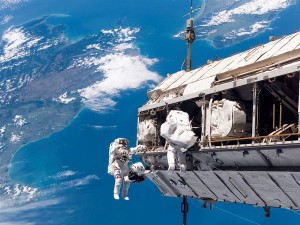Remote Viewing Session:
The International Space Station

The Task: Upgrading the International Space Station on December 25, 2006.
The Cue: Describe this event and place.
Monitor: Todd Ronan
The monitor and I were completely blind to the target and the cue.
The International Space Station is the largest man-made object orbiting Earth. A joint project including five different space agencies, the ISS serves as a research laboratory conducting experiments in biology, physics, meteorology and other fields. Occupied since November 2000, the station has housed the longest continual human presence in space.
In this session, I was tasked to remote view the International Space Station during an upgrade on December 25, 2006. I perceived a series of man-made objects, which together acted like a tuning fork that created feedback resonance between the objects. This resonance was associated with a theory on how things interact with each other. Some people believed that the theory was flawed and would fail. The resonance felt like an x-ray moving through my body, and it felt real to me. Long-term exposure to this feedback radiation affects the biology of those who are exposed to it, and it specifically affects the nervous system and the genetic code.
During post-session analysis and research, I learned that a group of Austrian scientists have proposed a series of experiments to test the theory of quantum entanglement using equipment on the Space Station. Quantum entanglement occurs when two connected but separated particles share information instantaneously. After installing a photon detection module onto one of the existing cameras on the Space Station, scientists on Earth will send individual entangled photons to the detection module.
Quantum physicists have successfully transported entangled photons 143 kilometers using lasers and 250 kilometers over optical fiber in the lab. The proposed tests using the Space Station would determine if it is possible to reliably transmit entangled photons over long distances, and may also shed light on gravity’s effect on quantum entanglement. If successful, these tests could prove the possibility of a satellite-based communication network using entangled photons. I don’t know if the 2006 upgrades to the ISS were related to the quantum entanglement research, but I believe my attention was pulled toward these experiments.
And here is a news clip about proposed quantum entanglement experiments that would be conducted on the International Space Station:
Post Your Comment on Facebook
Powered by Facebook Comments